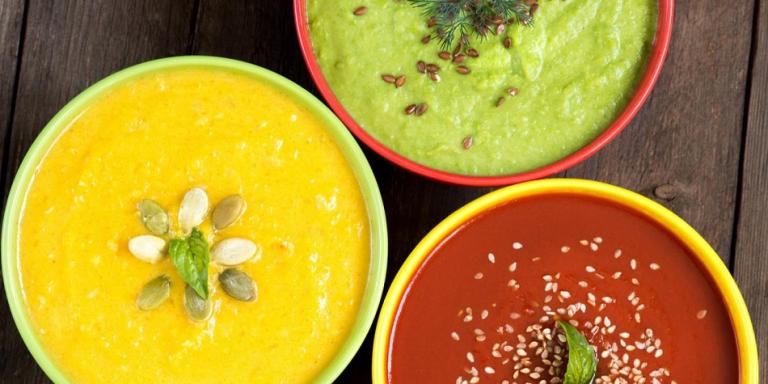Whether you’re making Classic Tomato Soup, Garden Gazpacho, or Rice Congee Soup, it helps to remember that soup is a forgiving dish, making it one of the best ways to experience the magic of cooking.
Soup offers the opportunity to learn about the fundamentals of cooking, from sautéing to caramelizing to the blending of techniques, textures, and flavors, all with easy-to-follow steps.
Further, soup is flexible, meaning you can tweak it to your palate’s content. Nevertheless, it’s always important to begin by reading through the recipe, checking that you have all the necessary ingredients, and then gathering all the needed equipment for the task. And for even greater assurance of success, follow my top ten tips for enlightened soup-making.
How to Make Great Soup
-
Know Your Salt and Pepper
Proper seasoning with salt and pepper is the key difference between a great soup and a humdrum soup. Salt is about as close to a magic ingredient as there is.
Proper seasoning with salt doesn’t make a soup salty; rather, the myriad complex flavors of the brew come to the fore. But add too much, and all your hard work can be ruined. To keep this from occurring in your kitchen, follow this technique: when seasoning with salt to taste near the end of cooking, get in the habit of using your fingertips instead of a shaker.
Simply place the salt in your palm or a small dish and pinch a small amount into the soup. This method allows far greater control of the salt added to the pot, and will also help you develop a tactile knowledge of how much is just the right amount. If you do over-salt your soup, there’s still hope: cut up a raw potato or two and drop it into the mix.
It will absorb some of the salt and make it more edible. Fresh peppercorns are likewise key to creating great soup. They have tremendous flavor, especially when compared to the preground& stuff. You can use your own pepper grinder or look for the new peppercorn bottles in the supermarket with the grinder built in.
-
Cut the Fat in the Sauté Step
Many soup recipes, including the ones I’ve developed here, begin by cooking and stirring aromatic vegetables—onions, garlic, peppers, ginger—in butter or oil.
These basic mixtures go by different names in different cuisines—a French mirepoix, an Italian soffritto, or a Portuguese refogado—but they all provide a foundation of flavor to the finished soup. But while more traditional recipes call for multiple tablespoons—even 1/2 cups or more—of fat, the soups in this collection rely on 1 or 2 teaspoons or tablespoons, at most.
The results are still delicious (the vegetables are softened and slightly caramelized), and the technique can be applied to other soups in your repertoire. (Note that if the vegetables stick a bit, simply add a small amount of broth or water to the pan.)
-
Don’t Go Stir Crazy
In the first phase of cooking the soup (i.e., cooking and stirring the onions, aromatics, and other vegetables), don’t stir the vegetables too often; once every two minutes or so is plenty. This helps them brown, caramelizing their sugars.
That, in turn, will further enhance the flavor of the soup without adding excess fat.
-
Puree Soup in Blenders, in Small Batches
When making puréed soups, use a blender for the creamiest texture. A food processor will give a slightly grainy texture. Handheld immersion blenders are excellent when you only want to blend soups a little bit, but they are not effective for making creamy purées. Be sure to purée in small batches and crack the blender lid slightly (or remove the center cap from the lid).
Steam can build up once you start blending, and if the lid is on tight or the blender is overfilled, it will spray hot soup all over you and your kitchen. For protection, cover the top with a dishtowel while puréeing.
Steer Clear of High Heat
As one who has scorched her fair share of soups in days gone by, I urge you to consider the following: keep the burner dial away from HIGH, even when bringing soup to a boil. It can take mere seconds for a soup to scorch if left unattended boiling on high heat.
-
Handle Dairy Additions with Care
Follow the directions carefully for adding dairy products to soup. Keep the heat relatively low to prevent the dairy product from separating; boiling will create an unpleasant texture.
Most soups in this collection call for the addition of any dairy products at the very end of cooking, with no more than a few minutes of gentle heating to warm completely. And if you’re making a soup ahead of time, prepare it up to the point of adding the dairy, then cool and store.
Reheat the soup when ready to eat, adding the dairy for quick heating just before serving.
-
Give Yourself Permission to Use Ready-Prepped Ingredients
Sure, fresh is best. But when you’re exhausted and hungry, my position is that a homemade soup made with a few shortcuts is still so much better—both in terms of taste and good health— than fast food. So go head and plan for those emergency moments.
Check out my list of pantry ideas, but also consider stocking up on frozen chopped onions and peppers, frozen diced potatoes (stocked with the hash browns in the supermarket freezer case), and minced jarred garlic for those times when you’re too pooped to peel and chop.
And don’t forget pregrated Parmesan cheese, prewashed greens, presliced mushrooms, and chopped vegetables from the supermarket salad bar, too.
-
Cut Vegetables Small for Faster Cooking
A 1/2-inch-size chop or dice needs no more than 10 minutes of simmering before it’s soft, speeding soup to the table in no time.
Head to the Deli Counter for Cooked Meat and Poultry
You don’t need to simmer meat and poultry for hours on end to pack a healthy, flavorful protein into soup. Head to the deli counter of your supermarket for a wide selection of fully cooked meats. Shred the meat from deli rotisserie chicken (discard the skin and freeze any leftover meat for future meals), or request thick cuts of roast beef, smoked turkey, and ham, then dice into small pieces at home. Because the meat and poultry are fully cooked, they only need a few minutes of warming in the final phases of cooking.
-
Add Instant Dazzle with a Drizzle, Splash, or Sprinkle
Elevate any enlightened soup, whether for everyday or entertaining, with a sprinkle or drizzle of one of the following: a few shavings of Parmesan cheese made with a vegetable peeler, flavorful oil (extra-virgin olive oil, hazelnut oil, toasted sesame oil), finely grated citrus zest, or ready-made condiments such as black olive tapenade, sun-dried tomato tapenade, or basil pesto.
A small splash of citrus juice (lemon or lime), red wine vinegar, cider vinegar, or good-quality balsamic vinegar can brighten and enhance the flavors of many soups, too. Visit our Soups & Stews recipes for some of our favorites.

